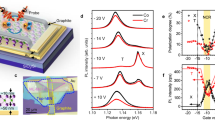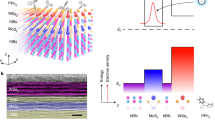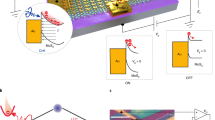Abstract
Two-dimensional semiconductors have a valley degree of freedom that could be used as a platform for future optoelectronic devices. The valley Hall effect, caused by electrons in different valleys having opposite Berry curvatures, is important for making such devices, but has only been reported with plasmonic structures or at cryogenic temperatures, limiting practical application. Here we report the observation of the valley Hall effect at room temperature in a molybdenum disulfide/tungsten diselenide van der Waals heterostructure. We show that the magnitude and polarity of the valley Hall effect in the heterostructure are gate tunable, which can be attributed to the contribution of the opposite valley Hall effect from electrons and holes in different layers. We use this gate tunability to create a bipolar valleytronic transistor.
This is a preview of subscription content, access via your institution
Access options
Access Nature and 54 other Nature Portfolio journals
Get Nature+, our best-value online-access subscription
$29.99 / 30 days
cancel any time
Subscribe to this journal
Receive 12 digital issues and online access to articles
$119.00 per year
only $9.92 per issue
Buy this article
- Purchase on Springer Link
- Instant access to full article PDF
Prices may be subject to local taxes which are calculated during checkout

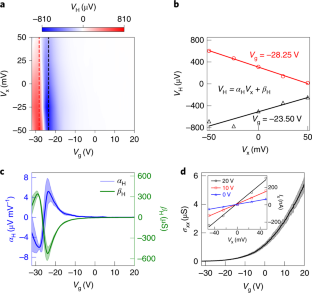
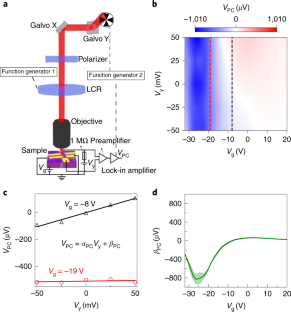
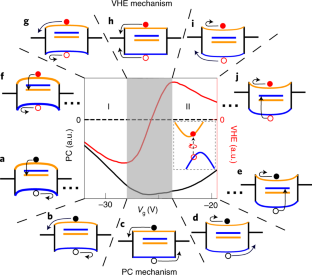
Similar content being viewed by others
Data availability
The data that support the findings of this study are available from the corresponding authors upon reasonable request.
References
Xiao, D., Yao, W. & Niu, Q. Valley-contrasting physics in graphene: magnetic moment and topological transport. Phys. Rev. Lett. 99, 236809 (2007).
Schaibley, J. R. et al. Valleytronics in 2D materials. Nat. Rev. Mater. 1, 16055 (2016).
Xiao, D., Liu, G.-B., Feng, W., Xu, X. & Yao, W. Coupled spin and valley physics in monolayers of MoS2 and other group-VI dichalcogenides. Phys. Rev. Lett. 108, 196802 (2012).
Liu, W. et al. Generation of helical topological exciton-polaritons. Science 370, 600–604 (2020).
Li, L. et al. Room-temperature valleytronic transistor. Nat. Nanotechnol. 15, 743–749 (2020).
Sundaram, G. & Niu, Q. Wave-packet dynamics in slowly perturbed crystals: gradient corrections and Berry-phase effects. Phys. Rev. B 59, 14915–14925 (1999).
Nagaosa, N., Sinova, J., Onoda, S., MacDonald, A. H. & Ong, N. P. Anomalous Hall effect. Rev. Mod. Phys. 82, 1539–1592 (2010).
Xiao, D., Chang, M.-C. & Niu, Q. Berry phase effects on electronic properties. Rev. Mod. Phys. 82, 1959–2007 (2010).
Mak, K. F., McGill, K. L., Park, J. & McEuen, P. L. The valley Hall effect in MoS2 transistors. Science 344, 1489–1492 (2014).
Lee, J., Mak, K. F. & Shan, J. Electrical control of the valley Hall effect in bilayer MoS2 transistors. Nat. Nanotechnol. 11, 421–425 (2016).
Yu, H., Liu, G.-B. & Yao, W. Brightened spin-triplet interlayer excitons and optical selection rules in van der Waals heterobilayers. 2D Mater. 5, 035021 (2018).
Cao, T. et al. Valley-selective circular dichroism of monolayer molybdenum disulphide. Nat. Commun. 3, 887 (2012).
Mak, K. F., He, K., Shan, J. & Heinz, T. F. Control of valley polarization in monolayer MoS2 by optical helicity. Nat. Nanotechnol. 7, 494–498 (2012).
Zeng, H., Dai, J., Yao, W., Xiao, D. & Cui, X. Valley polarization in MoS2 monolayers by optical pumping. Nat. Nanotechnol. 7, 490–493 (2012).
Jones, A. M. et al. Optical generation of excitonic valley coherence in monolayer WSe2. Nat. Nanotechnol. 8, 634–638 (2013).
Sallen, G. et al. Robust optical emission polarization in MoS2 monolayers through selective valley excitation. Phys. Rev. B 86, 081301 (2012).
Ubrig, N. et al. Microscopic origin of the valley Hall effect in transition metal dichalcogenides revealed by wavelength-dependent mapping. Nano Lett. 17, 5719–5725 (2017).
Gorbachev, R. V. et al. Detecting topological currents in graphene superlattices. Science 346, 448–451 (2014).
Kang, J., Tongay, S., Zhou, J., Li, J. & Wu, J. Band offsets and heterostructures of two-dimensional semiconductors. Appl. Phys. Lett. 102, 012111 (2013).
Liang, Y., Huang, S., Soklaski, R. & Yang, L. Quasiparticle band-edge energy and band offsets of monolayer of molybdenum and tungsten chalcogenides. Appl. Phys. Lett. 103, 042106 (2013).
Özçelik, V. O., Azadani, J. G., Yang, C., Koester, S. J. & Low, T. Band alignment of two-dimensional semiconductors for designing heterostructures with momentum space matching. Phys. Rev. B 94, 035125 (2016).
Karni, O. et al. Infrared interlayer exciton emission in MoS2/WSe2 heterostructures. Phys. Rev. Lett. 123, 247402 (2019).
Huang, Z. et al. Robust room temperature valley Hall effect of interlayer excitons. Nano Lett. 20, 1345–1351 (2020).
Jiang, C. et al. Microsecond dark-exciton valley polarization memory in two-dimensional heterostructures. Nat. Commun. 9, 753 (2018).
Rivera, P. et al. Valley-polarized exciton dynamics in a 2D semiconductor heterostructure. Science 351, 688–691 (2016).
Yu, T. & Wu, M. W. Valley depolarization due to intervalley and intravalley electron-hole exchange interactions in monolayer MoS2. Phys. Rev. B 89, 205303 (2014).
Rivera, P. et al. Interlayer valley excitons in heterobilayers of transition metal dichalcogenides. Nat. Nanotechnol. 13, 1004–1015 (2018).
Wilson, N. R. et al. Determination of band offsets, hybridization, and exciton binding in 2D semiconductor heterostructures. Sci. Adv. 3, e1601832 (2017).
Latini, S., Winther, K. T., Olsen, T. & Thygesen, K. S. Interlayer excitons and band alignment in MoS2/hBN/WSe2 van der Waals heterostructures. Nano Lett. 17, 938–945 (2017).
Li, H.-M. et al. Metal-semiconductor barrier modulation for high photoresponse in transition metal dichalcogenide field effect transistors. Sci. Rep. 4, 4041 (2014).
Yi, Y. et al. A study of lateral Schottky contacts in WSe2 and MoS2 field effect transistors using scanning photocurrent microscopy. Nanoscale 7, 15711–15718 (2015).
Lee, C.-H. et al. Atomically thin p–n junctions with van der Waals heterointerfaces. Nat. Nanotechnol. 9, 676–681 (2014).
Jeong, T. Y. et al. Spectroscopic studies of atomic defects and bandgap renormalization in semiconducting monolayer transition metal dichalcogenides. Nat. Commun. 10, 3825 (2019).
Liu, L. et al. Electrical control of circular photogalvanic spin-valley photocurrent in a monolayer semiconductor. ACS Appl. Mater. Interfaces 11, 3334–3341 (2019).
Rasmita, A. et al. Tunable geometric photocurrent in van der Waals heterostructure. Optica 7, 1204–1208 (2020).
Gunawan, O. et al. Carrier-resolved photo-Hall effect. Nature 575, 151–155 (2019).
Liu, Y. et al. Approaching the Schottky–Mott limit in van der Waals metal–semiconductor junctions. Nature 557, 696–700 (2018).
Wang, Y. et al. Van der Waals contacts between three-dimensional metals and two-dimensional semiconductors. Nature 568, 70–74 (2019).
Hu, G. et al. Coherent steering of nonlinear chiral valley photons with a synthetic Au–WS2 metasurface. Nat. Photon. 13, 467–472 (2019).
Sun, L. et al. Separation of valley excitons in a MoS2 monolayer using a subwavelength asymmetric groove array. Nat. Photon. 13, 180–184 (2019).
Acknowledgements
We acknowledge the discussion with F. Wang and W. Yao. W.-b.G acknowledges financial support from the Singapore National Research Foundation through its Competitive Research Program (CRP award Nos. NRF-CRP21-2018-0007 and NRF-CRP22-2019-0004), QEP programme and Singapore Ministry of Education (MOE2016-T3-1-006 (S)). Q.X. gratefully acknowledges National Natural Science Foundation of China (no. 12020101003), support from the State Key Laboratory of Low-Dimensional Quantum Physics and Start-up Grant from Tsinghua University. C.J. acknowledges the National Natural Science Foundation of China (no. 61974075); the Key Laboratory of Photoelectronic Thin Film Devices and Technology of Tianjin; and the Engineering Research Center of Thin Film Optoelectronics Technology, Ministry of Education of China. H.M. gratefully acknowledges the National Natural Science Foundation of China (no. 61704121), China Scholarship Council (no. 201709345003) and the Tianjin Natural Science Foundation (no. 19JCQNJC00700).
Author information
Authors and Affiliations
Contributions
C.J. and W.-b.G. conceived the project. C.J., Z.Z. and Z.H. performed the measurements. H.M., Q.T., S. Lai, N.W., S. Liu and X.L. fabricated the devices. C.J., Z.Z. and A.R. analysed the data. A.R. performed the theoretical analysis. C.J., H.M., A.R. and W.-b.G. wrote the manuscript. T.Y., Q.X. and W-b.G. supervised the project. All the authors contributed to the discussion of the results.
Corresponding authors
Ethics declarations
Competing interests
The authors declare no competing interests.
Additional information
Peer review information Nature Electronics thanks Yanping Liu and the other, anonymous, reviewer(s) for their contribution to the peer review of this work.
Publisher’s note Springer Nature remains neutral with regard to jurisdictional claims in published maps and institutional affiliations.
Extended data
Extended Data Fig. 1 Gate dependence measurement of VHE and longitudinal conductivity at 240 K in MoS2/WSe2 with 60° twist angle (AB-stacked).
(a) Optical image of the sample. The red dot is the 220 μW, 726 nm optical excitation location. The electronic configuration is as in Supplementary Fig. 4 in the Supplementary Information (source(drain): electrode 4(2), Hall electrodes: 1 and 3). (b) VH as a function of Vx and Vg. (c) The αH (proportional to VHE) and βH (proportional to CPC) as a function of Vg. The shaded area represents a 95% confidence interval. (d) Gate dependence of the longitudinal conductivity (σxx).
Extended Data Fig. 2 Gate dependence measurement of VHE and longitudinal conductivity at 240 K in MoS2/WSe2 with 20° twist VH angle.
(a) Optical image of the sample. The red dot is the 220 μW, 726 nm optical excitation location. The electronic configuration is as in Supplementary Fig. 4 in the Supplementary Information (source(drain): electrode 4(2), Hall electrodes: 1 and 3). (b) The VH as a function of Vx and Vg. (c) The αH (proportional to VHE) and βH (proportional to CPC) as a function of Vg. The shaded area represents a 95% confidence interval. (d) Gate dependence of the longitudinal conductivity (σxx).
Extended Data Fig. 3 Microscopic processes involved in band shift-induced valley current generation and modulation in MoS2/WSe2 heterostructure.
The yellow (blue) colour represents the MoS2 (WSe2) layer. Filled (empty) circles represent photogenerated electrons (holes). (a) Process 1: optical selection rule and process 2: charge transfer. (1) A circularly polarized light creates photogenerated electrons and holes in WSe2 with wavevector \({\bf{k}}_0\). (2) The electron undergoes charge transfer from WSe2 to MoS2, while the hole stays in WSe2. The optically induced valley current density in MoS2 (\({\bf {J}}_{{{\mathrm{v}}}}^{{{\mathrm{M}}}}\)) and WSe2 (\({\bf{J}}_{{{\mathrm{v}}}}^{{{\mathrm{W}}}}\)) have opposite directions. (b) Charge transfer process in the k space. The yellow (blue) arrows are the MoS2 (WSe2) photogenerated electron wavevectors \({\bf{k}}_i^{{{\mathrm{M}}}}\) (\({{\bf{k}}_i^{{{\mathrm{W}}}}} = {\bf{k}}_0\)), with respect to the MoS2 (WSe2) conduction band minimum (CBM). Due to the twist angle \(\theta\), the wavevector at MoS2 CBM (\({{{\mathrm{K}}}}_{{{\mathrm{M}}}}^{{{\mathrm{C}}}}\)) differs from the wavevector at WSe2 CBM (\({{{\mathrm{K}}}}_{{{\mathrm{W}}}}^{{{\mathrm{C}}}}\)) by \({\mathbf{\Delta}}_i^{{{{\mathrm{rot}}}}}\) (solid black arrows, \({\mathbf{\Delta}}_{3(2)}^{{{{\mathrm{rot}}}}} = R_{ + ( - )2\pi /3}{\mathbf{\Delta}}_1^{{{{\mathrm{rot}}}}}\)). The dashed black arrows (\({\mathbf{\Delta}}_i^{{{{\mathrm{ct}}}}}\)) are the C3 symmetry allowed wavevector change during the charge transfer (that is, \({\mathbf{\Delta}}_{3(2)}^{{{{\mathrm{ct}}}}} = R_{ + ( - )2\pi /3}{\mathbf{\Delta}}_1^{{{{\mathrm{ct}}}}}\)). Inset: addition of wavevectors in MoS2 and WSe2. Regardless of the twist angle, the effective velocity of photogenerated electrons in MoS2 has the same direction as in WSe2. (c) Process 3: current collection. The valley current (\(I_{{{\mathrm{v}}}}\)) is obtained by summing up the valley current from each layer (\(I_{{{\mathrm{v}}}}^{{{\mathrm{M}}}}\)and \(I_{{{\mathrm{v}}}}^{{{\mathrm{W}}}}\)), which depends on the valley current density as well the layer-dependent carrier transport efficiency (\(\eta _{{{{\mathrm{M(W)}}}}}(V_{{{\mathrm{g}}}})\) for MoS2(WSe2)). (d) Illustration of valley current gate dependence. The valley current polarity is gate tunable regardless of the twist angle. Here, \(\gamma _{{{{\mathrm{WM}}}}} = 0.9\) is used. The shaded area, region I, and region II definitions follow the ones in the main text Fig. 4.
Supplementary information
Supplementary Information
Supplementary Figs. 1–23 and Notes 1–6.
Rights and permissions
About this article
Cite this article
Jiang, C., Rasmita, A., Ma, H. et al. A room-temperature gate-tunable bipolar valley Hall effect in molybdenum disulfide/tungsten diselenide heterostructures. Nat Electron 5, 23–27 (2022). https://doi.org/10.1038/s41928-021-00686-7
Received:
Accepted:
Published:
Issue Date:
DOI: https://doi.org/10.1038/s41928-021-00686-7
This article is cited by
-
Inheritance of the exciton geometric structure from Bloch electrons in two-dimensional layered semiconductors
Frontiers of Physics (2024)
-
Excitonic devices based on two-dimensional transition metal dichalcogenides van der Waals heterostructures
Frontiers of Chemical Science and Engineering (2024)
-
Interlayer exciton dynamics of transition metal dichalcogenide heterostructures under electric fields
Nano Research (2023)
-
Recent developments in CVD growth and applications of 2D transition metal dichalcogenides
Frontiers of Physics (2023)
-
Room-temperature valley transistors for low-power neuromorphic computing
Nature Communications (2022)

